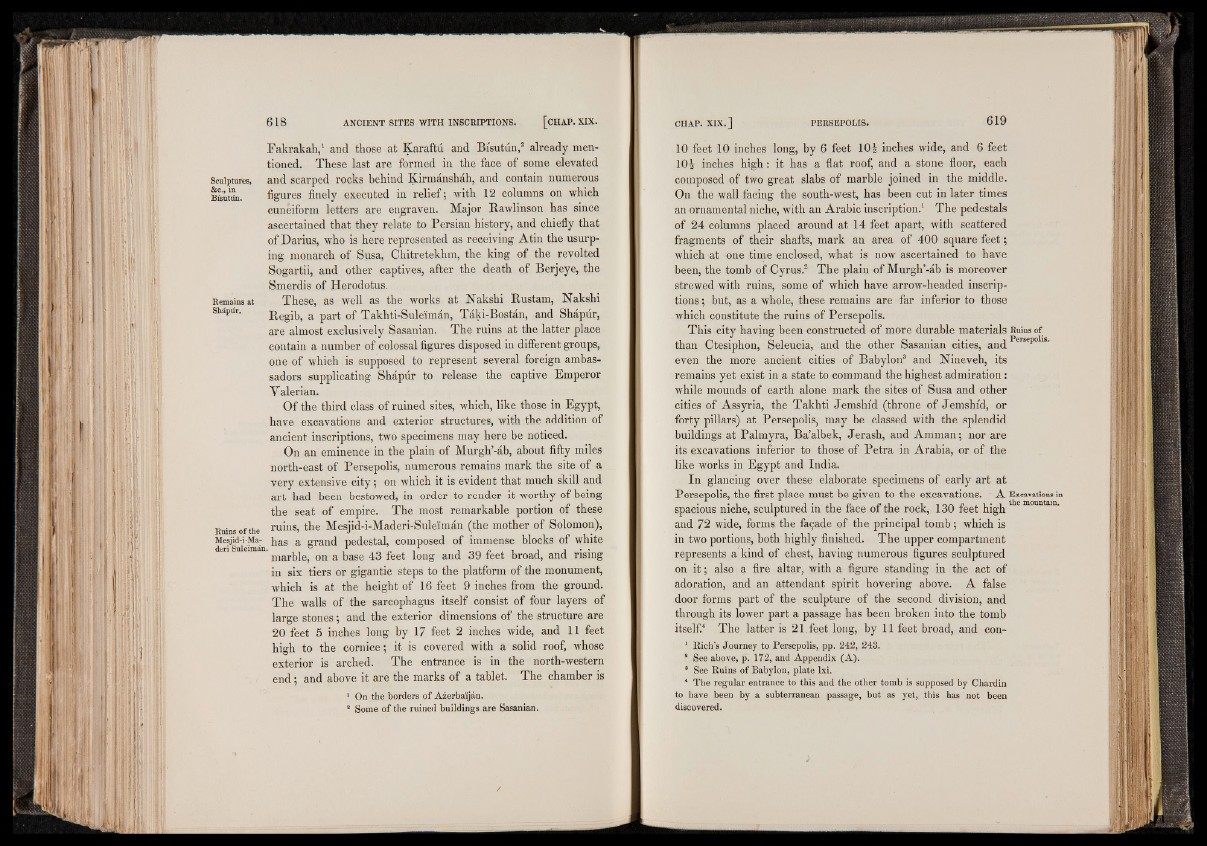
Fakrakah,1 and those at Karaftii and Bísutún,2 already mentioned.
These last are formed in the face of some elevated
Sculptures, and scarped rocks behind Kirmánsháh, and contain numerous
Bfeúttín. figures finely executed in relief; with 12 columns on which
cuneiform letters are engraven. Major Rawlinson has since
ascertained that they relate to Persian history, and chiefly that
of Darius, who is here represented as receiving Atin the usurping
monarch of Susa, Chitretekhm, the king of the revolted
Sogartii, and other captives, after the death of Berjeye, the
Smerdis of Herodotus.
Remains at These, as well as the works at Nakshi Rustam, Nakshi
ship*. j>egib; a part of Takhti-Suleimán, Táki-Bostán, and Shápúr,
are almost exclusively Sasanian. The ruins at the latter place
contain a number of colossal figures disposed in different groups,
one of which is supposed to represent several foreign ambassadors
supplicating Shápúr to release the captive Emperor
Valerian.
Of the third class of ruined sites, which, like those in Egypt,
have excavations and exterior structures, with the addition of
ancient inscriptions, two specimens may here be noticed.
On an eminence in the plain of Murgh’-áb, about fifty miles
north-east of Persepolis, numerous remains mark the site of a
very extensive city; on which it is evident that much skill and
art had been bestowed, in order to render it worthy of being
the seat of empire. The most remarkable portion of these
Ruins of the ruins, the Mesjid-i-Maderi-Suleimán (the mother of Solomon),
Mesjid-i-Ma- bas a grand pedestal, composed of immense blocks of white deri Suleimán. ° r 1 . n , , , marble, on a base 43 feet long and 39 feet broad, and rising
in six tiers or gigantic steps to the platform of the monument,
which is at the height of 16 feet 9 inches from the ground.
The walls of the sarcophagus itself consist of four layers of
large stones; and the exterior dimensions of the structure are
20 feet 5 inches long by 17 feet 2 inches wide, and 11 feet
high to the cornice; it is covered with a solid roof, whose
exterior is arched. The entrance is in the north-western
end; and above it are the marks of a tablet. The chamber is
1 On the borders of Azerbayán.
! Some of the ruined buildings are Sasanian.
10 feet 10 inches long, by 6 feet 10£ inches wide, and 6 feet
104 inches high : it has a flat roof, and a stone floor, each
composed of two great slabs of marble joined in the middle.
On the wall facing the south-west, has been cut in later times
an ornamental niche, with an Arabic inscription.1 The pedestals
of 24 columns placed around at 14 feet apart, with scattered
fragments of their shafts, mark an area of 400 square feet ;
which at one time enclosed, what is now ascertained to have
been, the tomb of Cyrus.2 The plain of Murgh’-ab is moreover
strewed with ruins, some of which have arrow-headed inscriptions
; but, as a whole, these remains are far inferior to those
which constitute the ruins of Persepolis.
This city having been constructed of more durable materials Ruins of
than Ctesiphon, Seleucia, and the other Sasanian cities, and eraepo s"
even the more ancient cities of Babylon3 and Nineveh, its
remains yet exist in a state to command the highest admiration :
while mounds of earth alone mark the sites of Susa and other
cities of Assyria, the Takhti Jemshid (throne of Jemshid, or
forty pillars) at Persepolis, may be classed with the splendid
buildings at Palmyra, Ba’albek, Jerash, and Amman ; nor are
its excavations inferior to those of Petra in Arabia, or of the
like works in Egypt and India.
In glancing over these elaborate specimens of early art at
Persepolis, the first place must be given to the excavations. A Excavations in
spacious niche, sculptured in the face of the rock, 130 feet high
and 72 wide, forms the façade of the principal tomb ; which is
in two portions, both highly finished. The upper compartment
represents a” kind of chest, having numerous figures sculptured
on it ; also a fire altar, with a figure standing in the act of
adoration, and an attendant spirit hovering above. A false
door forms part of the sculpture of the second division, and
through its lower part a passage has been broken into the tomb
itself.4 The latter is 21 feet long, by 11 feet broad, and con-
1 Rich’s Journey to Persepolis, pp. 242, 243.
s See above, p. 172, and Appendix (A).
* See Ruins of Babylon, plate lxi.
1 The regular entrance to this and the other tomb is supposed by Chardin
to have been by a subterranean passage, but as yet, this has not been
discovered.